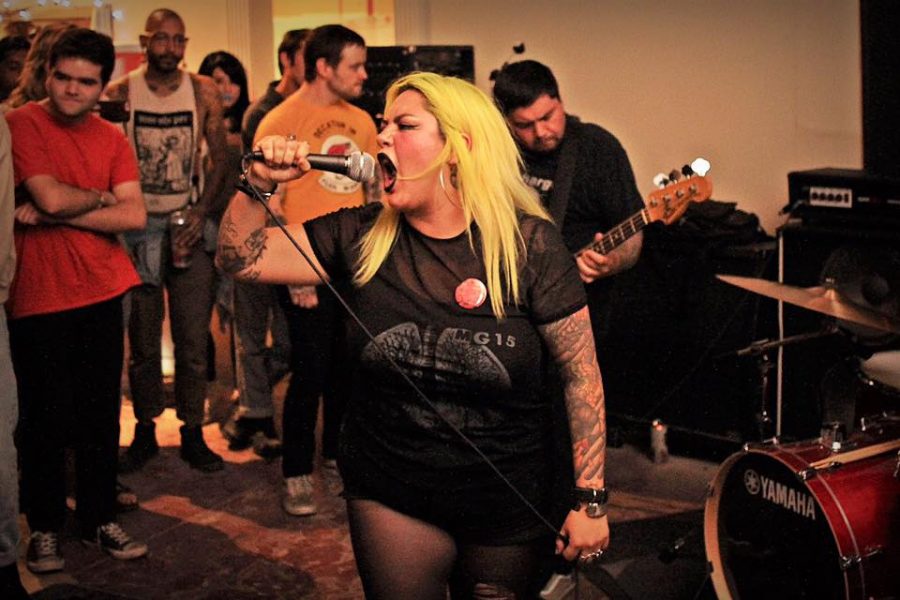Near the West side of downtown San Antonio, the auburn sun blankets the horizon. The hums and squeals of amplifiers alongside the chatter of youth echo down the dimly lit street leading to The Land in Between DIY, an art space for people from all walks of life to organize, discuss and empower one another.
The Land in Between DIY, located along 527 El Paso hosts a variety of events that gives the space the multifunctional usability of a Swiss Army knife. The community-supported space is a mix of people from all ethnic backgrounds, genders, social classes and places hosting music events, art exhibits, workshops and political activism.
The repurposed warehouse space has seen many changes over its lifetime, spawning from an electrician’s warehouse, the occupation of Cabeza de Piedra (an art collective) and Cafe Revolucion whose original sign is still displayed on the face of the building.
The current space was co-founded by Jose “Yole” Centeno and Arturo “Artie” Trejo in early 2017 as an effort to define what punk and community meant to them in a city with an evolving urban identity.
The pair of brown 20-something year olds are lending their axe in carving the currently thriving DIY music and arts scene in San Antonio not only through their own music, but by providing a space where people have a voice.
The urban identity and DIY scene of San Antonio has undergone constant change in the past decade. There has been a rise of non-conventional spaces for live music and art, which previously limited accessibility for both audiences and artists. These limitations existed not only in the sense of how space was used but also in the lack of resources available to people from the marginalized fringes of society, whether by gender, socioeconomic status or race.
“The idea behind it is a reflection of how we identify each other or how we see ourselves navigating through a city or community, whether it’s very concentrated or broad. We are part of what you would call the decentralized global network. We get to talk to people not only locally, but also nationally and on an international level,” Trejo said, “Homies would hit us up about a show and we always vaguely knew where we were going to do things and organize so the Land in Between is constant reminder of our bodies, where we are at and how we are pretty much stuck in this multi-layered society.”
“We exist,” Centeno adds.

These statements are important as so many young artists and voices find themselves without access to platforms to broadcast their message. Booking a space can become a hair-pulling ordeal when you don’t know who to contact, which often happens with bars and venues that work with already established talent.
“Those places made it really really inaccessible, especially for a teenager. They won’t take you seriously. They want a certain amount of money, and I feel like that because of that inaccessibility I experienced back in my time I don’t want that for anyone who wants to organize a show here,“ Centeno said, in reference to the struggles he experienced as a young musician.
To make up for the lack of shows at venues and bars, Centeno and Trejo relied upon the DIY ethos to spread their artistic expression. This would include unconventional spaces like A&A Drive In, a burger joint on Commerce street, to living rooms and backyards at places with eccentric names like Tofu House and Awful House where a young Centeno began organizing events.
The two are not alone in this decentralized global network. Folks are going outside of the norm to participate in artistic and political expression all over the world. Places like La Jolla’s Che Cafe, Austin’s Shirley’s Temple, Denver’s Rhinoceropolis, or Brooklyn’s 538 Johnson have been picking up the gap that conventional bars and venues often create for young artists.
The collaborative nature of these spaces create a wide and tight-knit community as Trejo mentioned.
Talent from all over the world graces the aged linoleum floor at the Land in Between DIY. From Brazil’s Rakta to New York’s Aye Nako to San Antonio’s Near Orbit Collective, there is no shortage of inclusivity of classes or genres and community on a national and international level.


“We all felt really welcome at our show at Land in Between. We could tell that a lot of heart, thoughtfulness and effort was put into the show, and those are things you can’t always get at non-DIY spaces/events,” mentioned Mars Gamito of queer punk band Aye Nako.
The inclusion at the Land in Between DIY is also highly political. Antifa flags, Anti-I.C.E. raid posters and gender-neutral bathroom signs are proudly hung around the facility. Near the entrance a list of rules explain to attendees of the culture within: sexism, racism, homophobia, transphobia, xenophobia, ableism, fatphobia and oppressive, bigoted and/or problematic behavior will not be tolerated.
“They (attendees) see what we have written on the wall, we constantly talk about respecting each other, and I feel like the foundation is laid,” Centeno said when asked if the Land in Between DIY’s beliefs bleed over into audience members.
“Safe spaces always have to be both revolutionary, calm, resilient, resistant, etc.,” said Trejo, “We recognize all genders, that’s very important. We’re not binary. We’re above that ideal. We’ve had a workshop on how to share knowledge with women of how to do sound, which is something we don’t see in San Antonio. After that, at the last three events we hosted women were setting up the board, which was awesome.”
The influence of the Land in Between DIY is slowly growing, and while DIY spaces are fragile systems and many are not sustainable long term, the duo remains optimistic and resilient about their mission.
“There’s not a lot of spaces like this in San Antonio and throughout the years there have been, but it’s been known that they get shut down, and we don’t want this space to get shut down. Even if we do happen to get shut down here we’ll find somewhere else,” Centeno and Trejo said, finishing each other’s sentences in complimentary solidarity.
With only four months in operation, the goal is to continue filling the calendar and grow the community of people who occupy the young space, even in the unpredictable landscape of operating a DIY community space.
The main idea is to foster expression from the youth to grow the arts community.
Centeno says, “They are the key to everything. They are the key to getting crowds out to see a hardcore band or a punk band, for example. People who drink beer and are over 21, people in their 30s and 40s don’t give a sh*t about touring acts. It’s always gonna come down to catering to the youth.”







